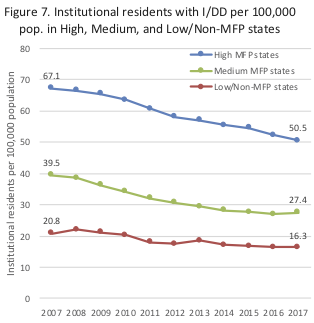Evidence for the Impact of the Money Follows the Person Program
Since 2007, states with Money Follows the Person (MFP) programs transitioned more than 90,000 people receiving long-term services and supports in institutions back to their homes and communities. Based on institutional population data from multiple sources and on LTSS expenditure data, analyzed separately for people with and without intellectual and other developmental disabilities, this report offers evidence that states with robust MFP programs fared better than states without MFP or with minimal MFP programs, both in terms of reducing institutional populations and expenditures and in rebalancing their LTSS systems. MFP is an important tool for states to use in reducing reliance on institutional services and shifting to home and community-based services.
Last modified Jul 23, 2019

